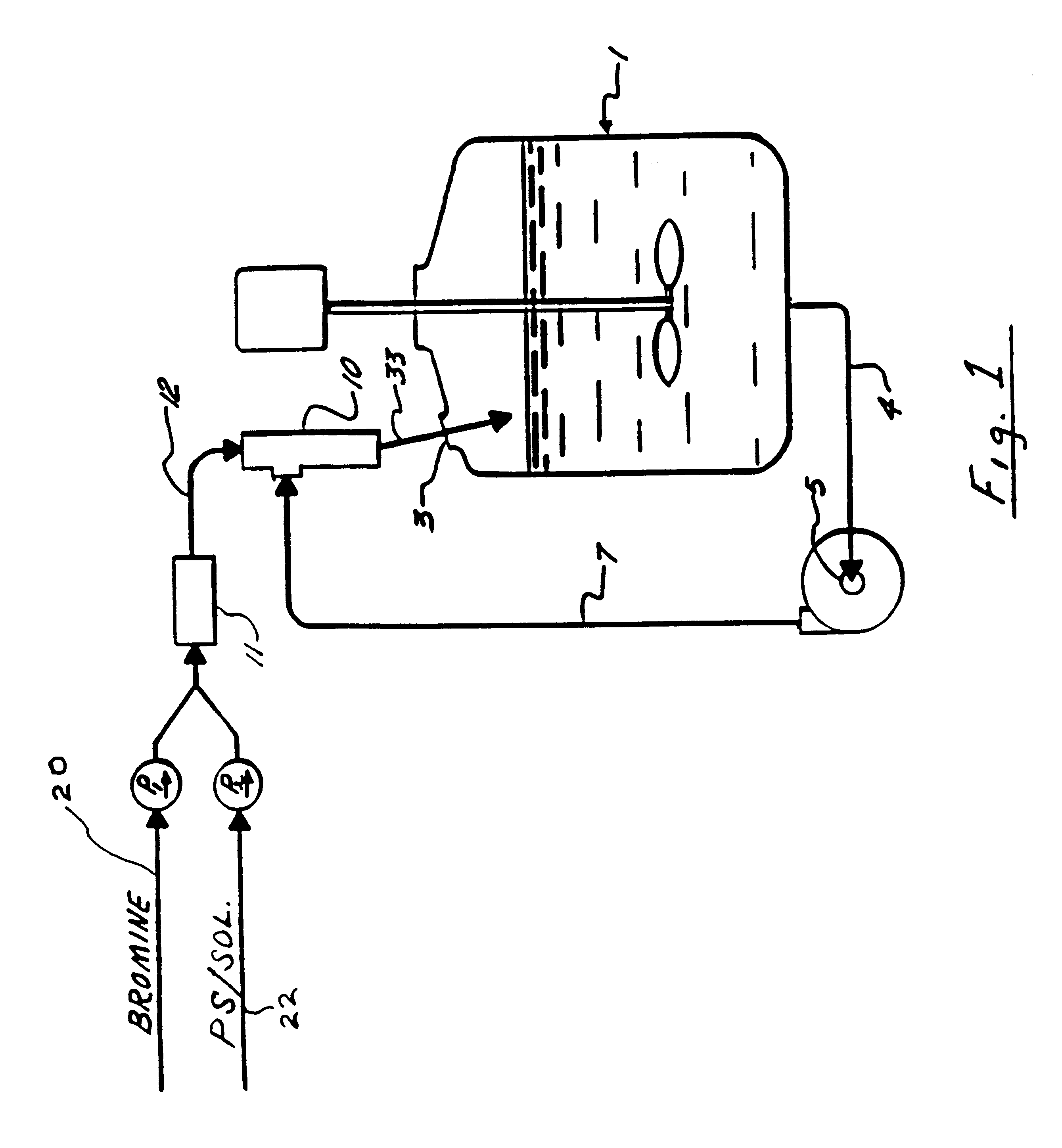Process for brominated styrenic polymers
a technology of styrenic polymers and brominated styrenic polymers, which is applied in the field of brominated styrenic polymers, can solve the problems of disadvantages of two solvents
- Summary
- Abstract
- Description
- Claims
- Application Information
AI Technical Summary
Benefits of technology
Problems solved by technology
Method used
Image
Examples
example i
Batch Bromination of Polystyrene Bromochloromethane Solvent
Bromine (683.5 g, 4.277 mole) was added over 75 minutes to a cooled (5.degree. C.) solution of 165.0 g (1.585 mole) of polystyrene (PS) dissolved in 1,188 ml (2,364 g) of anhydrous bromochloromethane (BCM) in the presence of 3.3 g (2.9 wt % based on PS) of aluminum chloride. Evolved HBr was scrubbed by a caustic solution during the reaction. A cook period of 2 hours at 5.degree. C. with nitrogen purge was effected. The reactor contents were diluted with 2,444 ml (4,863 g) BCM, washed with 2,000 ml water, aqueous sodium sulfite (30 g in 2,000 ml water) and then with 2,000 ml water. The aqueous and organic layers were separated. The organic layer was added batchwise into 7,000 ml of 90.degree. C. water with agitation. BCM was removed with a Dean-Stark trap from the return distillate. The mixture was cooled and the solid product was filtered, washed (with water) and dried at 150.degree. C. to obtain 477 g (95% yield) of bromina...
example ii
Batch Bromination of Polystyrene Ethylene Dichloride Solvent
The bromination of PS was repeated as in Example I except as indicated in the Table. The amount of ethylene dichloride, EDC, used was in the same volume proportion as the BCM used in each step. The analytical results for the product are in the Table.
example iii
Pre-mix of Polystyrene and Bromine for the Bromination of Polystyrene Bromochloromethane Solvent
A Y-shaped mixing apparatus having a cooling jacket was equipped with 2 feed lines, each connected to a pump. One of the feed lines was for delivering bromine and the other was for L delivering a PS and BCM solution. Bromine (93.3 g, 31.3 ml or 0.583 mole), delivered at a rate of 1 ml / min (19.4 mmol / min), and a PS / BCM solution (22.4 g PS, 0.215 mole and 97 ml or 194 g of anhydrous BCM), delivered at 4 ml / min (7.17 mmol / min), were fed simultaneously from their respective feed lines into the cooled (5.degree. C.) Y-mixing apparatus. The resultant intimate mixture from the mixing apparatus was then fed into a cooled (5.degree. C.) suspension of 0.45 g (2 wt % based on PS) of aluminum chloride in 49 ml (98 g) of anhydrous BCM. Evolved HBr was scrubbed by a caustic solution during the reaction. The feeds were complete in 35 minutes and the mixture was cooked for 2 hours at 5.degree. C. After w...
PUM
| Property | Measurement | Unit |
|---|---|---|
| Angle | aaaaa | aaaaa |
| Temperature | aaaaa | aaaaa |
| Weight | aaaaa | aaaaa |
Abstract
Description
Claims
Application Information
 Login to View More
Login to View More - R&D
- Intellectual Property
- Life Sciences
- Materials
- Tech Scout
- Unparalleled Data Quality
- Higher Quality Content
- 60% Fewer Hallucinations
Browse by: Latest US Patents, China's latest patents, Technical Efficacy Thesaurus, Application Domain, Technology Topic, Popular Technical Reports.
© 2025 PatSnap. All rights reserved.Legal|Privacy policy|Modern Slavery Act Transparency Statement|Sitemap|About US| Contact US: help@patsnap.com

